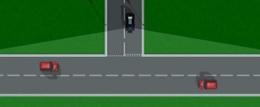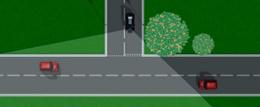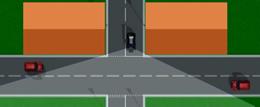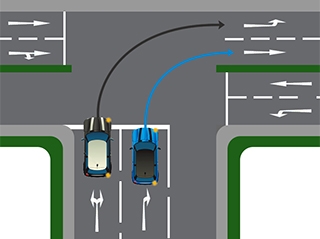Road Junctions Tutorial
When taking your practical driving test your examiner will expect you to:
Use the MSM and PSL routines effectively and in good time
Brake gently and in good time
Position your vehicle correctly
Look for pedestrians, obstacles and traffic
Read road signs correctly
Assess the speed of traffic.
Approaching A Junction
- the amount of traffic at the junction
- warning signs
- road markings
- direction signs
- ‘Give way’ and ‘Stop’ signs
- traffic lights
Priorities At Junctions
Give way signs, road markings, stop signs, and traffic lights indicate priorities. On an uncontrolled junction, where there are no signs or markings indicating priority all vehicles have equal priority. If you encounter an uncontrolled junction, you should slow down, look for traffic in all directions, and be prepared to stop and give way if necessary.
Pedestrians and Priority
If you turn into a road that pedestrians have already started to cross, they have priority, and you must give way.
Emerging From Junctions
- as you approach the junction check your mirrors
- signal if necessary
- position your car to the left of the road with the front bumper just behind the stop or give way line
- reduce your speed and be prepared to stop and give way
- before pulling out, look in all directions, check your left mirror for cyclists and motorcyclists passing on your nearside
- as you pull out check your mirrors and accelerate to a safe speed
- make sure your indicator is cancelled
- Follow the above procedure but position your car as close to the centre of the road as you can.
Assessing Traffic Speed
Remember, you must be able to pull out of a junction without forcing other vehicles to slow down or change position. On the other hand, you mustn’t hesitate and miss a valid opportunity to pull out (do this on your driving test, and you will earn a minor fault).
To make such judgments takes a driver some time to learn. However, whether an experienced driver or not, it is likely that you have experience in crossing a road on foot.
So when waiting to pull out into traffic, ask yourself this question – given the current road traffic situation would I cross the road on foot?
If the answer is yes, it is likely to be safe to pull out in your car.
Choosing The Correct Gear To Use
As a general rule, the most versatile gear to select when taking a junction is second. However, the second gear may not always be the appropriate gear to use. The gear you select will depend on the safe speed for the corner. The safe speed depends on how far ahead you can see into the junction and the angle through which you will need to turn.
A wide, gentle turn with a clear view ahead can be taken at a higher speed than a narrow road with a restricted view, so such a turn can be taken using third gear. If the angle of the turn is very sharp and the view into the junction restricted, you may have to slow right down and select the first gear.
Whichever gear you select, make sure you use it. Never ‘coast’ (travelling with the car in neutral gear or with your clutch pedal pressed down) around the corner. Coasting will reduce the control you have over the braking and steering.
Open Junctions
An open junction allows you to see clearly in both directions as you approach it. Such junctions are actually quite rare. They will have a Give Way sign and road marking.
When at an open junction, if the road ahead is clear, you don’t have to stop, just slow down to a speed that will enable you to emerge safely from the junction.
Closed Junctions
Most junctions are closed junctions. They offer a limited view in one or both directions as you approach them. Again they will have a Give Way sign and road marking.
Blind Junctions
These give a restricted view even when at the Stop Line. They have a Stop sign and road marking, so you must come to a stop before emerging from the junction. To safely negotiate them, inch your way forward until you can see the road is clear. If another vehicle approaches, you should stop and wait for a clear gap.

Open Junction

Closed Junction

Blind Junction
Lane Discipline At Junctions
- turn left – keep to the left-hand lane
- follow the road ahead – keep to the left-hand lane
- turn right – move to the right-hand lane in good time.
- turn left – keep to the left-hand lane
- follow the road ahead – keep to the left-hand or middle lane
- turn right – move to the right-hand lane in good time.
Two-Lane Junctions

Where there are two or more lanes marked for the direction you wish to take, choose the most convenient lane for you.
If you don’t know which lane you need to take, road signs and lane markings leading to the junction should be able to give you the correct guidance.
Unless you need the right lane at the next junction, it is normally better to select the left lane. This will avoid you having to change lanes after you turn. If you select the right lane for the turn, check carefully to the left after you turn to make sure there is no one in your blind area before returning to the left lane.
Signs and Road Markings

Distance to give way line ahead

Staggered Junction

Crossroads

T-Junction

Junction on a bend

Stop and give way

Distance to stop line ahead

Distance to stop line ahead

Give way to traffic from the right at roundabouts

Stop line at stop sign

Stop line at stop sign

Seen on the road just before give way sign
